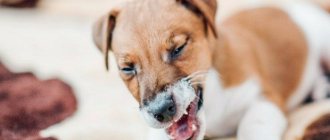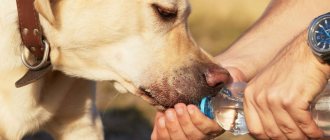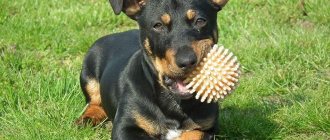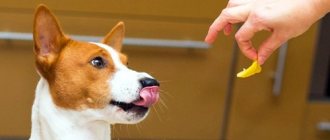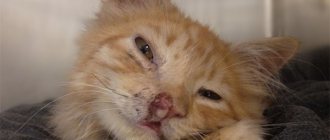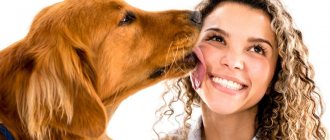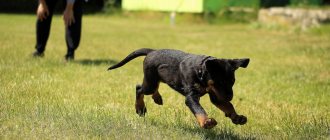Dog owners know very well that when a dog is healthy, it has a good appetite and looks cheerful. Adult dogs are fed by their owners twice a day; puppies and young dogs are fed more than twice a day. When a dog refuses its next meal, animal owners should not worry because... this will in no way affect her health. A dog owner should be concerned if your friend refuses food for 36-48 hours.
When is it normal to refuse food and water?
If the dog always empties the bowl and impatiently waits at the dinner table for each portion, the owner will be alarmed by a sudden refusal to eat. But in some cases, lack of appetite is a normal reaction of the animal.
Cases when refusal to eat is normal:
- The disease takes away the dog's strength. An exhausted body is not ready to process food. Make sure your pet has the opportunity to eat.
- The second half of pregnancy can provoke short-term refusal of food. Your dog may lose or gain significant weight. It is important that fasting is not accompanied by refusal of water and heavy breathing.
- Excessive nutrient loading. Sometimes the dog’s body receives excess food, in such cases a break is necessary so that the food is absorbed and the dog feels normal.
- Stress or bad mood. Refusal to eat can be caused by rude treatment, a short walk or fear. The dog rarely refuses more than one feeding.
- If the dog is not in any danger, it is cheerful and has no fever. If the dog has a cold and wet nose, there is no need to treat the pet.
The reasons why a healthy dog refuses to eat are described in the video. The video was presented by the channel “Me and My Tail”.
Estrus, second half of pregnancy and childbirth
Hormonal changes often affect a dog's appetite. One of the reasons for refusing food can be estrus. During estrus, sex hormones are released in large quantities, which can cause the animal to reduce activity and cause poor sleep. Sometimes bitches in heat experience problems with their well-being, as well as pain and discomfort. The dog does not want to eat or drink.
During pregnancy, due to changes in the body, the water-salt and protein balance is disturbed. Deviations can lead to decreased appetite or complete refusal to eat. In cases where the refusal of food does not exceed one or two feedings, there is no need to worry.
Signs indicating that your dog is sick and you need to see a specialist:
- the animal is weak;
- the dog is not active;
- barely moves and has lost weight;
- sad and does not play;
- vomiting is observed;
- The refusal to eat has been going on for two days now.
Lack of appetite is also normal in a situation where a dog has given birth. An animal may not eat after experiencing a colossal load, which is childbirth.
Overabundance of nutrients
Often, owners, fearing that the dog is not receiving enough nutrients, may overdo it with vitamin and mineral supplements. In this case, food refusal is often observed; the dog may be active, but thin. Under no circumstances should you overfeed your dog or force him to eat; you should allow the animal to recover.
During the treatment of the disease
It is not uncommon for a dog to refuse to eat when sick. Refusal to eat can be triggered by various symptoms and diagnoses.
Reasons why a dog may not eat:
- a new diet prescribed by a veterinarian;
- nausea;
- stomach pain;
- dental problems;
- postoperative period.
In some situations, it may be enough to change the food, reheat the food, or choose food with a stronger smell to stimulate your pet's appetite. If these methods do not help, you should take the animal to the veterinarian.
Stress
Dogs can react to stressful changes in their environment. Pets like everything in the house to match their own sense of order. An unusual environment, the appearance of a new family member or animal can make the dog worry, and stress will affect its appetite. A sad pet will eat poorly or refuse to eat until it feels safe and calm again.
Analyzing various causes and situations will help you decide what problem is causing the change in appetite and restore healthy eating. The owner knows his dog best and will pay attention when he sees any change in his behavior.
Pickiness
Dog owners who tend to indulge their pets face a problem when the animal begins to be picky about food. An absolutely healthy pet refuses food, may not eat for days and demands to change food. Small breed dogs are especially susceptible to this behavior. Often the phenomenon is provoked by owners who pamper the animal. As a result, the pet develops confidence that whims will allow him to get more tasty and often harmful food.
It should be remembered that dogs are mono-dieters. This means that nutrition should be balanced, not varied. Moreover, it is necessary to take into account the fact that you cannot constantly change your pet’s diet. The transition from one type of food should be slow. When changing the diet, you should carefully monitor your pet's condition.
Teething
A puppy's baby teeth fall out between the ages of eight and ten weeks, while the molars do not erupt until seven months. During the period of active tooth growth, the animal may refuse to eat, which is associated with pain and the inability to gnaw. This behavior is normal if it is not accompanied by vomiting and fever in the animal.
Hot weather
Inexperienced dog owners are frightened by situations where the dog is lethargic and refuses to eat in the heat. It is possible that the cause of this behavior could be illness or a tick bite.
If the veterinarian has confirmed that the animal is healthy, you just need to adhere to the following rules:
- You need to make sure that the animal always has access to water. In hot weather, a state of dehydration occurs, which is dangerous for the dog’s body. You need to change your drink twice a day.
- You should feed your dog early in the morning and late in the evening when the heat subsides. At such a time, the pet will be able to eat more food.
- Reduce the number of feedings.
- If the owner is afraid or does not want to feed the animal less often, it is worth reducing the calorie content of the food consumed by the animal.
- Trying to tempt your pet with tasty food should be avoided. Let the dog eat as much food as it deems necessary.
- You can freeze fruit or some food. Due to their anatomical structure, dogs are not susceptible to sore throats, and a piece of ice will help cheer them up. You should not give your dog ice cream, it is too high in calories and can harm the animal.
Old age
A common situation is when an old dog begins to refuse food. Often, starvation is associated with a loss of smell; the animal ceases to realize that the food offered to it is edible. The solution is simple - show your pet that food can be eaten - feed it by hand or inject it into the mouth with a syringe without a needle.
It is not uncommon for an animal to develop dental problems as it ages. It is worth giving up solid food and carefully monitoring your diet.
The Children of Fauna channel will tell you about the reasons why a dog refuses to eat.
Parvovirus gastroenteritis
Parvovirus is the smallest virus that infects vertebrate animals.
Resistant to environmental influences, withstands low temperatures, adapts well to high temperatures. Only boiling kills the virus. All types of dogs are at risk of the disease, regardless of breed.
The main outbreak occurs in spring, continues in summer and autumn, and subsides in winter. Young individuals under the age of one year are more susceptible due to poorly developed immunity. But older dogs, when their immunity is already significantly weakened, are also at risk of becoming infected.
Young dogs are more susceptible to the disease.
The disease is spread by recovered pets and currently ill pets.
Peculiarities
The latent period of the disease can last up to three days.
- There are three periods of pathology - incubation, clinical and final periods.
- The latent period can last up to three days.
- As a rule, the disease occurs in two forms - gastroenteritis with myocarditis and gastroenteritis.
- By severity - mild, moderate and severe.
Symptoms
The severe course begins with absolute apathy.
- A mild degree is characterized by slight apathy, loss of appetite, diarrhea, and less commonly vomiting.
- The average degree is manifested in refusal to feed, diarrhea, constant vomiting, and abdominal pain.
- A severe course begins with absolute apathy, the animal does not react to external stimuli, constantly lies, does not eat, does not drink.
- Increased salivation is observed, body temperature rises, and fever begins. The pet constantly feels sick, with frequent progressive vomiting.
- The diarrhea then progresses and becomes debilitating, leading to severe dehydration.
- For small puppies, the pathology can result in death.
Treatment
Before the doctor arrives, you should take your temperature.
- Before the doctor arrives, you should take your temperature.
- Forcibly feeding and drinking is prohibited.
- If you have diarrhea and no vomiting, you can try to replenish lost fluid. To do this, prepare a solution: for one liter of boiled water, take 3.5 g of table salt, add baking soda in the amount of 2.5 g, potassium chloride in a dose of 1.5 g and sugar in the amount of 20 g. Give your pet small doses - 40 ml per kilogram of body weight. If you have Ringer-Locke solution in your house, you can replace it with this solution.
- Drug treatment is prescribed only by a doctor.
- The first sign of recovery is the appearance of appetite.
Possible health problems when refusing food
A situation where a pet refuses food for several days can be a signal of dangerous diseases. Fasting for two days indicates the need to take the animal to the veterinarian on the third day.
Dental problems and oral diseases
According to statistics, dental problems are present in more than sixty percent of dogs over the age of three years. The main cause of disease is lack of attention to oral hygiene on the part of owners. At the same time, the dog often refuses food due to pain or the inability to grind food.
The most common oral diseases in dogs are:
- periodontitis;
- periodontal disease;
- tartar;
- gingivitis (or inflammation of the gums);
- caries;
- stomatitis;
- enamel dysplasia;
- tooth fractures;
- oral injuries;
- sialadenitis;
- malocclusion.
Ear diseases
Dog ears are extremely susceptible to inflammation and injury. You should carefully monitor their condition in your pet, clean and inspect them regularly. Ear diseases can make the animal lethargic and deprive it of appetite.
The most common problems:
- otodectosis;
- otitis;
- eczema;
- tick bite;
- auricular hematoma.
Chemotherapy for cancer
If certain symptoms appear in your animal, you should immediately contact a veterinarian and have your pet diagnosed for cancer. If diagnostics confirm the presence of a cancerous tumor in your dog, your veterinarian may recommend chemotherapy.
Gastrointestinal diseases
Dogs, like other predatory animals, suffer from diseases of the gastrointestinal tract. Stomach pain can lead to decreased appetite.
The most common gastrointestinal diseases:
- poisoning;
- blockage of the pharynx and esophagus;
- gastritis;
- peptic ulcer;
- intestinal obstruction;
- gastroenteritis;
- colibacillosis;
- abdominal dropsy.
Foreign body
While learning about the world around them, dogs often try to chew on all sorts of objects. Many of these foreign bodies pass through the intestinal tract without incident or consequences for the dog's body, others can become stuck and cause problems.
Some of the most common foreign bodies that cause problems in a dog's gastrointestinal tract are:
- corn cobs;
- sticks;
- bones;
- threads;
- balls;
- fishing hooks;
- stones;
- toys;
- socks/stockings.
The clinical signs observed vary widely and depend on the degree of obstruction and the location and type of foreign body. If the dog does not eat, trembles, breathes frequently and heavily, immediately contact a veterinarian, as a foreign body may have entered the body.
Pain syndrome
Pain can cause complete indifference to food. Unfortunately, it is not always possible to easily determine from a pet’s behavior that it is in pain. Symptoms are usually unclear, especially if the dog tends to hide when sick.
However, there are a number of signs by which you can determine that your pet is experiencing pain:
- The dog whines or growls more often. If your dog is acting louder than usual, you should be wary.
- Limping when your pet puts pressure on the area is an obvious sign of pain.
- Dogs in pain lick their paws constantly in an attempt to calm themselves. When animals are in pain, one of their first instincts is to clean the wound by licking it. Even if there is no wound, animals will still lick the area in an attempt to get rid of the pain.
- Many dogs will sleep more when they are in pain because they are trying to heal that way or have difficulty moving around. There is a loss of appetite, a change in the way of eating and the amount of water consumed.
- Changed breathing signals a problem. Breathing is shallow and frequent. These may be signs that your pet is having trouble breathing.
- If your dog is in pain, the pain may prevent him from sitting or lying down. You should be wary when your pet is sitting, lying in an unusual position, or cannot stay still. For example, over and over again he tries to sit or lie down and almost immediately gets up and moves around again.
- Aggressive behavior is a sign of pain. When animals get injured, many of them go into protective mode and try to force their owner to stay away. The pet subconsciously fears that the owner will cause pain. An obedient dog will suddenly growl, lay its ears flat against its head, and even bite if its owner does something that bothers it. Typically, aggressive dogs sometimes exhibit the opposite behavior.
Infectious viral or bacterial diseases
Infectious diseases caused by bacteria are the most common in dogs. Most of them can seriously affect the dog's condition and appetite.
Common bacterial diseases that affect dogs include:
- Bortadella or Kennel Cough. An upper respiratory infection, usually caused by Bordetella bronchiseptica.
- Leptospirosis. A bacterial disease caused by a spirochete (a type of bacteria) is spread through contact with a dog's urine. Symptoms include vomiting, decreased urination, dark urine, and fever.
- Spotted fever is a tick-borne disease. The bacteria Rickettsia rickettsii is carried by ticks and transmitted to the dog through a bite. It is a contagious disease. Signs and symptoms in dogs include lethargy, depression, high fever, loss of appetite, cough, conjunctivitis, difficulty breathing, leg swelling and joint and muscle pain.
Viral infections in dogs are often easy to treat, but some can be fatal.
Here are some of the most common viral infections that you should protect your dog from:
- Parvo is a viral infection that affects dogs. Although the disease affects pets of all ages, puppies are more susceptible to the disease. The contagious infection is spread through contact with the dog's saliva, vomit and feces.
- Distemper is another viral infection. The virus is related to human measles and is highly contagious. Young puppies and older dogs are much more susceptible, but an adult dog that has not been properly vaccinated can become infected.
- Canine hepatitis is another common viral infection in dogs. It mainly attacks the liver. The disease rarely affects older animals. Most dogs become ill before one year of age.
Post-traumatic shock
Since dogs cannot explain to their owners what they are thinking or experiencing, it is necessary to try to infer these things from their behavior.
Behaviors that may indicate post-traumatic shock:
- the dog does not walk, resists when trying to lead it somewhere;
- fear and urination during greeting;
- unmotivated aggressive behavior;
- the paws give way, the dog staggers or trembles;
- the pet is not sleeping;
- the dog is afraid of people.
The factors influencing appetite in dogs are discussed in the video from UA DOG.
In what cases should you contact a veterinarian?
Our four-legged friends have very good health, so if you have any problems, you should contact a veterinarian. Especially if:
- diarrhea;
- vomit;
- high temperature (above 38.5°C in adult animals);
- suspicious discharge from the genitals;
- the body was covered with a red rash and blisters;
- a tumor appeared.
See a doctor urgently if the dog is hiding in a dark place, sitting with its head turned toward a corner, its head bowed, its eyes dull. Such symptoms indicate a dangerous disease. Only timely and adequate treatment will save the animal’s life.
Probable causes based on accompanying symptoms
Symptoms that indicate the reason that the dog does not eat, does not drink, but only lies.
| Causes | Symptoms |
| Overabundance of nutrients |
|
| Stress |
|
| Ear diseases |
|
| Gastrointestinal diseases |
|
| Oncology |
|
| Foreign body |
|
| Post-traumatic shock |
|
Intussusception
Intestinal obstruction is a serious pathology in which the pet dies if timely assistance is not provided.
Blockage may occur due to eating fragile bones.
The causes of intussusception are as follows:
- blockage of the intestines by foreign bodies;
- infringement;
- vascular embolism.
Blockage can occur due to eating fragile bones or when swallowing foreign objects - pieces of wire, pebbles, a piece of polyethylene. This type is called ileus. In children, blockage by crowded balls of worms is possible.
Incarceration may occur due to gastric torsion or strangulated hernia.
in the cavities of blood vessels , resulting in blockage of blood vessels and obstruction.
Symptoms
With gastric pathology, progressive vomiting is observed.
Pronounced signs occur with pathology of the stomach and duodenum.
With this development of events, progressive vomiting, complete apathy of the animal, and severe pain are observed. The patient's condition is rapidly deteriorating. Symptoms may only manifest in the form of general weakness and apathy, and occasionally vomiting. The further fate of the dog depends only on the speed of the owner’s reaction. Delay can be fatal.
Treatment
There is no drug solution to the problem. Intussusception can only be eliminated through surgery .
After surgery, the doctor prescribes anti-inflammatory drugs.
If necrosis of intestinal tissue is observed, the doctor performs a bowel resection. In the postoperative period, the doctor will prescribe anti-inflammatory drugs, antibiotics, and medications that support the patient’s general condition.
How to normalize a dog's appetite
In order to restore your pet's appetite, you need to pay attention to a number of things. After carefully analyzing the dog's behavior, the owner will understand how to help.
Regular physical activity
Regular training will stimulate your dog's appetite and encourage him to eat more. To really increase appetite and get the enhancing effects of exercise, take your dog for a walk before each meal. It won't take long for him to associate walking with food, creating a positive association for both activities.
Some types of dogs require more activity. Ideally, your pet should exercise every day or at least several times a week. If you are unable to participate in physical activity, there are many ways to get your dog exercise. Buy special toys for your dog and make him fetch them, go to a dog park and let him play freely.
Feeding at the same time every day
Feed your pet twice daily, at the same times, or as recommended by your veterinarian. Often the dog is healthy and energetic, but gets distracted, doesn’t finish the food and leaves. Do not leave the bowl for the whole day; remove it after half an hour, even if the dog has not eaten all the food. Quite quickly the dog will understand that it needs to eat when the owner gives food. There will be no snacking, and appetite problems will disappear on their own.
If your pet doesn't eat dry food
Dogs often like wet food, but it gets dirty and is more expensive than dry food, which is usually not a good choice for owners. Regardless of why you want to switch your pet to dry food, consult your veterinarian first. If the doctor approves your choice, you will need to slowly add dry food to wet food.
This will prevent your dog from getting stomach problems. During this time, it is recommended to eliminate any other food sources, such as human food or treats, so that you can evaluate whether the food is suitable for your dog or not.
What else can you do to make your dog willing to eat dry food?
- Change your diet slowly.
Switching your dog from wet food to dry food is not something you can do overnight. For best results and to avoid any digestive upset for your furry friend, take your time switching from one food to another. Although your dog may be resistant to the change at first, you can help him gradually get used to dry food. The way you present him at mealtimes will have a big impact on how he accepts the shift.
To enhance the flavor, you can lightly warm the croquettes in the microwave.
- Wet diet.
You can first mix the dry food with, for example, low-salt chicken or beef broth or a little tuna juice from a can, or regular canned dog food will also work. This will not only soften the food, but also improve the aroma and taste. To control the calories, you can use a mixture of warm water and broth or canned food.
- Warm water.
One way to make dry food more attractive is to add warm water. This will help to better reveal the taste and aroma of food and make it more appetizing. To begin, mix the food with just a few tablespoons of warm water and wait until the food is soaked. You can always add more liquid if you want the food to be softer - or if you want to mash it into a puree.
- Switch to higher quality food.
There are currently a huge number of different dry foods on the pet products market, which can vary significantly, including in quality. Super premium and holistic diets contain much more muscle meat and fewer carbohydrates than cheaper foods. If you've tried economy or mid-range dog food without success, try switching to a higher quality diet and experimenting with flavors until you find one your dog likes.
Remember that for some dogs, wet food is better than dry food. In addition, your veterinarian may recommend a raw diet or home-cooked diet if health conditions warrant it.
How to make a dog eat
Getting your dog's appetite back will largely depend on the underlying cause of the anorexia. Often, after solving this problem, the desire to eat food returns. Sometimes this may take several days and additional measures may be required. Depending on your dog's condition, your veterinarian may give an injection, tablet, or powdered food supplement to stimulate his appetite.
They need to be treated with caution, as they do not solve the problem - they simply make the animal want to eat. In some cases, if your pet is recovering or treatment lasts longer than a couple of days, doctors may suggest inserting a feeding tube (feeding tube). It goes into the esophagus so your dog can get liquid food through it. This is not forever - you just need to feed the dog until they start eating on their own.
If you are concerned about your dog's appetite, contact your veterinarian. Finding and treating the root cause is the best way to approach this situation.
What can't you do?
Basic prohibitions that dog owners must adhere to:
- Don't feed your dog from your table. Most animals will prefer a piece of steak and mashed potatoes to a balanced dog food. The dog will express his gratitude for the treat in every possible way. Over time, the habit will lead to the dog constantly begging for food.
- Supervise your children so that they do not feed the complaining dog.
- If the dog does not eat, there is no need to offer him treats and junk food to encourage him.
- Do not force feed your dog unless recommended by a veterinarian. Overeating is much more harmful to a dog's body than starvation.
Loading …
General preventive measures
As you know, the best treatment is good prevention. To avoid unpleasant surprises, you should be extremely attentive to your pets. It is necessary to carefully monitor the quality of feed.
- Timely medical examination is the key to good health and well-being of your pet.
- It is necessary to carefully monitor the quality of food, not to take risks and not experiment with new brands from unknown manufacturers.
- Always carefully study the composition and possible vitamin and mineral supplements.
- If you want to supplement your diet with useful substances, consult your doctor.
- Systematic deworming is of no small importance. It is necessary to periodically treat your dog for fleas and carefully inspect the skin for ticks.
- Avoid access to household chemicals, poisons, and paint and varnish products.
- The dog's utensils and habitat must be systematically sanitized and disinfected.
- In addition, when arranging a place for an animal to live, one should exclude the possibility of drafts and dampness, as well as the possibility of overheating from direct sunlight.
